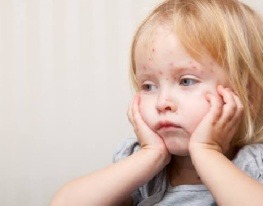About Us

Chicken Pox
CHICKEN POX is a common, very itchy and highly contagious viral skin infection affecting children and young adults. It is caused by the Varicella-Zoster Virus (VZV). 90% of the reported cases occur in children less than 10 years of age. Its onset is marked with fever, which is often associated with fatigue, muscle aches, headaches, throat pain and eye congestion. Within 24 hours, the patient notices pink spots which rapidly turn into small fluid-filled blisters. These blisters can occur anywhere on the body, including scalp, genitals and inside the mouth; but are most numerous over the trunk. The diagnosis is made based on clinical appearance alone. Chicken pox is spread through inhalation and not direct skin to skin contact. Thus it is very common for a patient to not have any recollection of coming in contact with an infected individual.
The disease is contagious 1 day before the appearance of the rash to 6 days after. When the rash starts to scab, it becomes non-infectious. The symptoms of chicken pox are much more severe in adults, who will require anti – viral medication. The anti-viral medication will not completely stop the appearance of new rashes and blisters, but it will protect you from secondary infections like pneumonia and encephalitis. Consult your physician immediately if you have symptoms of breathlessness or chest pain. In children, the symptoms are quite mild and your dermatologist may decide to treat your child with paracetamol, vitamins and anti – histamines (for the itch) alone. You can continue to bathe, but you must remember to pat dry post-shower and not rub. Complete bed rest is essential, and you will have to take leave from your school or office since this is a communicable disease. Ask your dermatologist for a medical certificate.
Pregnant women with chicken pox, suspected chicken pox or who have been exposed to a child with chicken pox, MUST NOT neglect it. They should consult their dermatologists and obstetricians immediately.
Once you have had chicken pox, you will remain immune to it for the rest of your life. Second attacks are practically unheard of. However you are likely to develop shingles on your next exposure to the VZV virus. This is because, even after you have recovered from the chicken pox, the VZV remains dormant in some of your nerve ganglions for several years. It gets activated again on a second exposure to the same virus, and can cause Shingles.
After the end of your treatment, and when all your lesions have scabbed, remember to wash all clothes and bed linen in hot water. Clean your room and furniture with an antiseptic like Lysol or Savlon. Do not itch and resist the urge to pick at your scabs, if you want to prevent marks and scars. The rashes are very superficial and will heal without scarring if they are cared for well and not picked at. Stay out of the sun. Do not skip meals. Drink plenty of water and get enough rest and sleep. You can continue to bathe.
SHINGLES (Medical term Herpes Zoster) is a highly contagious infection caused by the same virus which is responsible for chicken pox. It presents as blisters which appear on only one area and one side of the body. The blisters are preceded by pain and burning at the affected site. Zoster too becomes non-infectious when the blisters scab. But unlike chicken-pox, shingles can heal with scarring, pigmentation or persistent pain and burning over the affected site. Zoster is common in middle-aged individuals and complications are more likely in the elderly. It is important to treat zoster with anti-virals.
VACCINE – A single dose vaccine given under the skin can protect against Chicken pox. Individuals older than 13 years, will require a booster dose after 8 weeks. There is a separate single dose vaccine against Zoster as well. Vaccines only provide temporary protection but can protect you from severe illness and complications. Consult your Pediatrician for more information.

